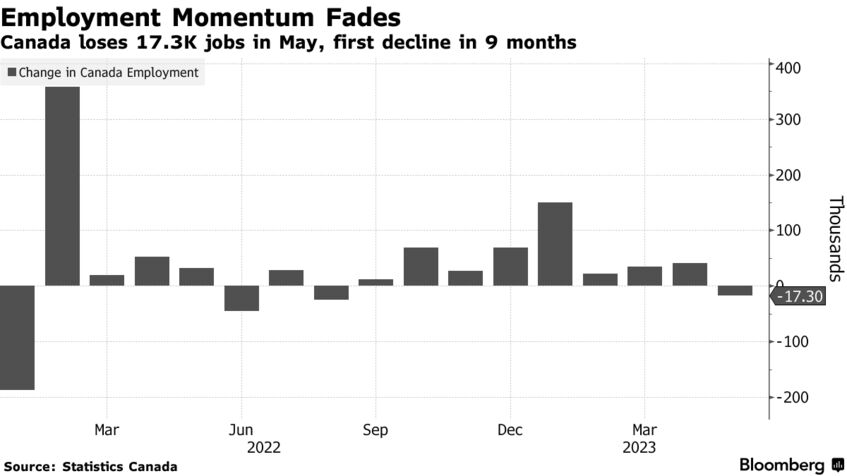Canada’s economy ended its eight-month run of employment gains with minor job losses, mostly concentrated among youth and self-employed people.
The country shed 17,300 jobs in May while the unemployment rate rose 0.2 percentage points to 5.2%, the first increase since August, Statistics Canada reported Friday in Ottawa. The figures missed expectations for a gain of 21,300 positions and a jobless rate of 5.1%, according to the median estimate in a Bloomberg survey.
Bonds rallied and the loonie gave back earlier gains versus the US dollar. The yield on Canadian government two-year notes declined about 6 basis points to 4.49% at 9:12 a.m.
May’s data ended the longest run of job gains since 2017, in which 423,900 positions were created. The magnitude of job losses, however, was considered statistically insignificant and didn’t even offset half the gains seen in April. Losses were accompanied by robust wage gains, running at more than a 5% yearly pace for the fourth straight month, highlighting a still-tight labor market and an economy that’s proving resilient in the face of higher borrowing costs.
“Some cracks appeared within the Canadian labor market in May, but these may not yet be wide enough to convince the Bank of Canada that inflation is about to meaningfully cool off,” Andrew Grantham, an economist at the Canadian Imperial Bank of Commerce, said in a report to investors.
After an unexpectedly strong start to the year, Canada’s jobs market had been still showing momentum into the second quarter. A tight labor market, on top of strong economic growth, sticky inflation and a rebound in housing market activity, prompted Governor Tiff Macklem and his officials to raise the overnight lending rate to 4.75% on Wednesday after declaring a pause on hikes in January. Policymakers said excess demand in the economy “looks to be more persistent than anticipated.”
In May, total hours worked fell 0.4% on a monthly basis, the most since April 2022, and were up 2.2% compared to a year earlier. The participation rate was down 0.1 percentage points to 65.5% in May, mostly reflecting a decline in the participation rate for youth aged 15 to 24.
The employment rate declined 0.3 percentage points to 62.1%, as employment didn’t keep up with the pace of strong population growth.
Job losses were led by decreases in the business, building, and other support services sector, which includes activities that support the day-to-day operations ranging from waste management to administrative services.
Employment declined in Ontario, Nova Scotia, and Newfoundland, and Labrador, while it rose in Manitoba and was little changed in other provinces.
This jobs report is the first of two employment data releases before the Bank of Canada’s next rate decision on July 12.


